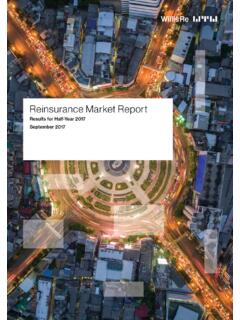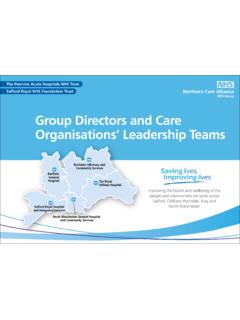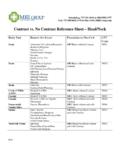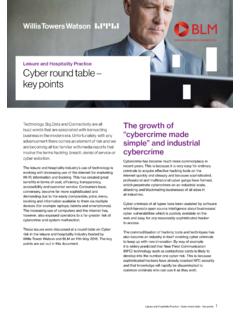Transcription of ECONOMIC CAPITAL MODEL VALIDATION - Welcome To …
1 ECONOMIC CAPITALMODEL VALIDATIONM arkus StrickerWillis ECONOMIC CAPITAL ForumDavid SimmonsWillis ReDave IngramWillis ReContentsAbstract ..1 Section I: Introduction ..2 Section II: Motivations for MODEL VALIDATION ..3 Lessons from the banking industry ..3 Insurance regulation ..3 Rating agencies ..5 Section III: Structuring a VALIDATION process: what, who, What: assessing the level of MODEL risk ..7 Who should validate? ..8 How: an overview ..8 Section IV: Proposed VALIDATION process ..9 1. Conceptual risk ..9 2. Implementation risk ..11 3. Input risk ..12 4. Output risk ..13 5. Reporting risk ..14 Considerations for specific types of sub-models ..15 Conclusion ..18 Appendix: Sample VALIDATION checklist.
2 19 1. Conceptual risk ..19 2. Implementation risk ..19 3. Input risk ..19 4. Output risk ..19 5. Reporting risk ..19 Considerations for specific types of sub-models ..20 References: ..21 Page 1 ECONOMIC CAPITAL MODEL ValidationAbstractThe paper considers ECONOMIC CAPITAL MODEL (ECM) VALIDATION from different viewpoints: regulators, management, rating agencies and parallel developments in the banking sector. VALIDATION is a necessity, and yet standardized ECM VALIDATION processes are underdeveloped. This can lead to inefficient and person-dependent validations, which are certainly undesirable for both management and regulators. We outline explicit guidance for ECM VALIDATION to foster a more standardized, efficient process.
3 Those involved in a MODEL VALIDATION project are our intended audience; MODEL developers may also benefit from the paper, but will have to translate the VALIDATION guidelines into development guidelines. Many articles on ECM VALIDATION formulate rather general principles that are not easily translated into explicit guidance. We believe this is a consequence of imprecise definitions of MODEL risk. Since the purpose of VALIDATION is to assess the level of MODEL risk, it is imperative to work with a practical definition of MODEL risk. In this paper we provide a definition of MODEL risk consisting of five sub-categories: conceptual risk, implementation risk, input risk, output risk, and reporting risk.
4 Our VALIDATION guidance in the following sections is derived from this providing detailed assessment guidance for each of the five MODEL risk sub-categories, we propose a classification scheme for MODEL VALIDATION results. The embedding into a process yields a natural sequence for assessing the MODEL discussion of conceptual risk starts by emphasizing the need for careful description of the purpose of the MODEL , its applications, and its users. Without these it is impossible for the VALIDATION team to assess the adequacy of the concepts and whether the presentation of the output is useful decision support for the users. Clear documentation of the limitations of the MODEL concepts is very important.
5 Most of the guidance in the implementation risk section comes from best practices for software engineering. For complex software, the realistic question is not whether it contains errors, but rather whether the errors it contains are substantial. Various test techniques are input risk section discusses the different types of input and how they can be validated or benchmarked. This category of risk is typically the most familiar to actuaries, although we feel that there is often too much emphasis on extracting all the information from internal data and not enough attention to peer group if conceptual, implementation and input risk have been assessed positively does it make sense to assess output risk.
6 We make a distinction between output risk and reporting risk: the former deals with the full data set of outputs and checks whether the MODEL yields reasonable values, while the latter deals with the manner in which selected outputs are presented to users. The outputs must be calculated correctly, but this alone is not sufficient; even correct outputs may be highly sensitive to input parameters, which is an undesirable MODEL risk deals with the communication of MODEL results. A report, normally containing only a small fraction of the MODEL outputs some statistical measures is provided to users of the ECM. In the evaluation of reporting risk, we assume that the output reflects the company s risk situation well; we focus on the selection and presentation of key figures.
7 As these can have significant influence, they must be assessed in the light of the intended use and the users. This is by far the most difficult part of ECM VALIDATION , because the VALIDATION team members themselves are influenced by the report content and format. We recommend that this assessment is done by the most senior VALIDATION team , we observe that larger ECMs typically have several sub-models; the guidance of assessing MODEL risk sub-categories applies to each of these. We discuss specific VALIDATION issues of typical ECM sub-models for a property / casualty insurance company. It is noteworthy that a positive assessment of each sub- MODEL is insufficient; their aggregation needs to be assessed as RISKA sound process for ECONOMIC CAPITAL MODEL VALIDATION requires a clear definition of MODEL risk.
8 In this paper we identify five sub-categories: conceptual risk, implementation risk, input risk, output risk, and reporting 2 Section I: IntroductionEconomic CAPITAL Models (ECMs) have become a ubiquitous tool for larger, complex insurers. These models are used in three main ways: to inform the process for managing risks and optimizing returns on risk, to allow management to determine an appropriate level of CAPITAL to hold for their retained risks, and to satisfy regulatory requirements. These three uses overlap to greater and lesser extents in different territories. But for all three uses, it is extremely important that the underlying concepts are consistent with the intended application of MODEL results, and that the MODEL produces results which are consistent over time.
9 The process of assuring both types of consistency is called MODEL VALIDATION is required for many overlapping reasons. If regulators or senior managers base decisions on the output of an ECM, then they should understand the MODEL s assumptions, restrictions and output and should ensure that the MODEL is suitable for the specific application. But since there are few commonly accepted standards for MODEL VALIDATION , the validating party often receives an overwhelming amount of documentation without the benefit of a standard format or framework for this material. The complexity of modern ECMs demands a more structured VALIDATION process that can be understood by decision VALIDATE?
10 As statistician George Box famously said: All models are but some are useful. The purpose of VALIDATION is to assess the degree of MODEL risk, and ensure that this is not so severe as to prevent the MODEL being fields provide a wealth of experience with VALIDATION processes from which we can learn. In software development [1], a lot of effort goes into test procedures; in engineering, approval of a new jet engine requires a stringent VALIDATION process; and in the pharmaceutical industry, getting a new drug approved requires an extensive acceptance process. These disciplines have recognized the need to standardize the process of VALIDATION and approval. Such standardization also aids the process of communicating the results of VALIDATION to the executives who are the ultimate initial approval, jet engines and pharmaceuticals are subjected to periodic quality control tests to assure that initial specifications are being maintained.











